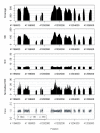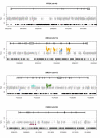Accurate and exact CNV identification from targeted high-throughput sequence data
- PMID: 21486468
- PMCID: PMC3088570
- DOI: 10.1186/1471-2164-12-184
Accurate and exact CNV identification from targeted high-throughput sequence data
Abstract
Background: Massively parallel sequencing of barcoded DNA samples significantly increases screening efficiency for clinically important genes. Short read aligners are well suited to single nucleotide and indel detection. However, methods for CNV detection from targeted enrichment are lacking. We present a method combining coverage with map information for the identification of deletions and duplications in targeted sequence data.
Results: Sequencing data is first scanned for gains and losses using a comparison of normalized coverage data between samples. CNV calls are confirmed by testing for a signature of sequences that span the CNV breakpoint. With our method, CNVs can be identified regardless of whether breakpoints are within regions targeted for sequencing. For CNVs where at least one breakpoint is within targeted sequence, exact CNV breakpoints can be identified. In a test data set of 96 subjects sequenced across ~1 Mb genomic sequence using multiplexing technology, our method detected mutations as small as 31 bp, predicted quantitative copy count, and had a low false-positive rate.
Conclusions: Application of this method allows for identification of gains and losses in targeted sequence data, providing comprehensive mutation screening when combined with a short read aligner.
Figures




References
-
- Walsh T, Lee MK, Casadei S, Thornton AM, Stray SM, Pennil C, Nord AS, Mandell JB, Swisher EM, King M-C. Detection of inherited mutations for breast and ovarian cancer using genomic capture and massively parallel sequencing. Proc Natl Acad Sci USA. 2010;107(28):12629–12633. doi: 10.1073/pnas.1007983107. - DOI - PMC - PubMed
-
- Bentley DR, Balasubramanian S, Swerdlow HP, Smith GP, Milton J, Brown CG, Hall KP, Evers DJ, Barnes CL, Bignell HR, Boutell JM, Bryant J, Carter RJ, Keira Cheetham R, Cox AJ, Ellis DJ, Flatbush MR, Gormley NA, Humphray SJ, Irving LJ, Karbelashvili MS, Kirk SM, Li H, Liu X, Maisinger KS, Murray LJ, Obradovic B, Ost T, Parkinson ML, Pratt MR. et al.Accurate whole human genome sequencing using reversible terminator chemistry. Nature. 2008;456(7218):53–59. doi: 10.1038/nature07517. - DOI - PMC - PubMed
Publication types
MeSH terms
Substances
Grants and funding
LinkOut - more resources
Full Text Sources
Other Literature Sources
Miscellaneous

